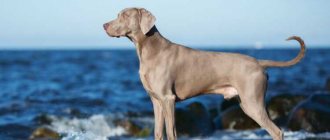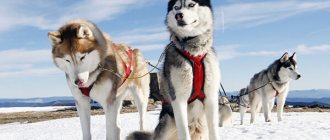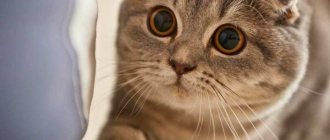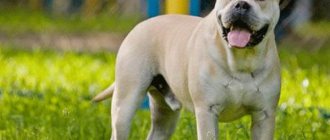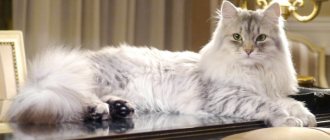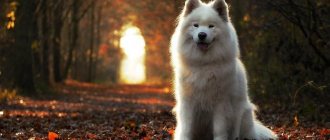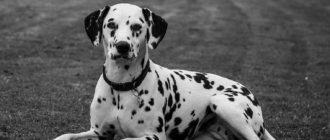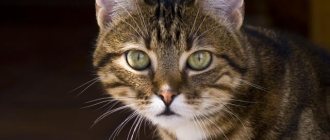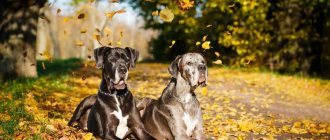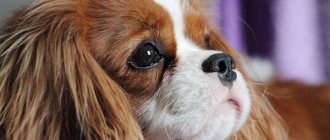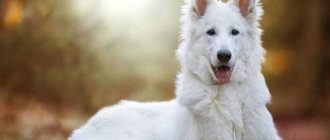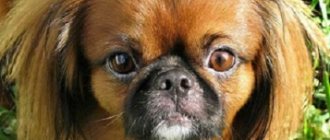Samoyed huskies are one of the most ancient dog breeds on Earth. They have a charming appearance, a wonderful flexible character and developed intelligence. They are very loyal to their owners and can withstand adverse weather conditions well. In large families, Samoyeds will make friends with older children, and for kids they will become gentle and caring nannies.
The coat of Samoyed huskies does not cause allergies, so those who suffer from this disease can undoubtedly adopt them.
The owners will be proud not only of the unusual appearance of their pet, but also of the status of the owner of a dog of such a rare breed, because in Russia there are only 2,500 of them.
Brief history and characteristics of the breed
Scientists believe that the history of the Samoyed Laika breed goes back almost three thousand years. During all this time, Samoyeds have remained virtually unchanged. Their habitat was very limited, so they could not interbreed with other breeds. Actually, that’s why they are classified as primitive animals, which means there is no human intervention in the breeding of this breed. As a result, dogs have excellent health.
Currently, there is an opinion that the Samoyed is a hypoallergenic dog. They shed only twice a year, their fur does not have a special “dog” smell, and dandruff never forms on their skin. This means that allergens will not constantly fly around the house.
Why is the Samoyed husky called that?
There are two versions of the origin of such an unusual name for representatives of this dog breed.
According to the official version, these dogs were bred by some peoples living in the north of Siberia and the Urals, who are classified as Samoyedic groups. In ancient times they were called “samoyedny” or “samoyad”, which means “those who live separately, on their own, alone.” Gradually, the dogs living next to them were also named this way.
The second version of why this white husky is called a Samoyed has not been scientifically confirmed. Once upon a time, dogs of this breed were sled dogs. Against the background of snow, the white fluffy dogs harnessed to the sleigh were invisible. It seemed that the sleds were moving without anyone’s help, so they began to be called “self-eating” or “samoyeds”. Later, the dogs harnessed to them received this name.
It is important! Officially, the breed is referred to as a Samoyed or Samoyed dog. You can often find its other names - Samoyed Laika or Arctic Spitz, but these are nothing more than artistic comparisons.
Dossier
Adult height: 53 - 69 cm (male), 48 -53 cm (female). Weight: 20-30 kg. Characteristic color: white, cream with tan. Coat length: double structure (short dense undercoat and long outer coat). Life expectancy: 12-14 years. Advantages of the breed: very attached to the owner and friendly, quite intelligent and quick-witted. They do not require special care and are odorless. Difficulties of the breed: require intense exercise and active walks. Average price: $250-1100 depending on the pedigree and purpose of the dog. Classification: medium breed, sled dog and companion dog.
Interesting Facts
Interesting facts about this ancient breed:
- Samoyed Huskies love cats and treat them exclusively as play partners.
- In the cold, the Samoyed's coat fluffs up: the stronger the frost, the more fluffy the Samoyed's coat becomes.
- The Nenets often leave Samoyeds with them in the tent and sleep with them in an embrace so as not to freeze.
- The first representatives of this breed came in three colors: white, brown and black. Nowadays, brown and black coat colors in Samoyeds are considered a deviation. Such individuals cannot participate in exhibitions.
Breed description, standards and appearance
The Samoyed dog is a medium-sized white husky with a luxurious coat, a smile on its face and a muscular yet graceful physique. Dogs have thick fur: long main coat and very thick undercoat. The breed standard was first formulated in England in 1909. There, zoologist Ernst Kilburn-Scott founded the first Samoyed dog kennel. The latest edition of the breed standard was approved by the FCI in 1997.
According to the current standard, the size at the withers of Samoyed girls is usually 53-56 cm, boys - 57-60 cm. A deviation of 3 cm is allowed, both up and down. The average weight of adult males is 25–30 kg, females – 17–25 kg.
It is important! The size of adult female Samoyed dogs is always smaller than that of males.
The current ICF standard gives the following characteristics of the Samoyed breed:
It is important! Samoyed Laika girls have a slightly longer back than boys.
It is important! According to the ICF classification, the Samoyed dog belongs to group 5 “Spitz and primitive breeds” of section 1 “Northern sled dogs”.
Varieties of Samoyed Laika
Representatives of the Samoyed Laika breed are of the following types:
It is important! Representatives of both types should be harmoniously built.
Character and behavior
By nature, the Samoyed Laika is a friendly, cheerful, courageous dog. She is very devoted to her owner, follows him everywhere and cannot stand being alone. Some individuals sometimes show stubbornness and independence, and can run away during a walk. In this case, the owner needs to be patient with his pet.
Samoyeds are very attentive. They monitor the mood of their owner and quickly respond to changes in it. These sociable huskies quickly find a common language with the rest of the family and try to always be in the center of events.
This is interesting! The Samoyed dog has a well-developed freezing instinct. If you hug a Samoyed, for example, in a dream, he will try not to move so as not to disturb the person’s sleep.
Representatives of the breed usually behave warily with unfamiliar people, but without aggression, and can even allow themselves to be petted. Such a dog is unlikely to make a good watchman or security guard, because the ability to work in a team is inherent in it at the genetic level. The Samoyed dog has no developed hunting instinct, so they can live side by side with any pets without any problems.
Attitude towards children
The Samoyed is considered one of the most fun sled dogs. These shaggy goodies retain their playfulness until old age and will never refuse to play, for example, with a ball. They are active and noisy, love attention, and puppies are even overly hooligan. That is why Samoyed huskies get along well with children, steadfastly withstanding their importunity. Very young children should not be allowed to play with Samoyeds, as they show their feelings towards children with excessive assertiveness.
Training
For training to bring positive results, you can train a Samoyed at the age of two months. The standard training scheme will not bring the desired result. For training to be successful, the following few points should be taken into account:
- The dog will not monotonously execute the same commands. A Samoyed should be interesting and fun.
- Avoid putting unnecessary pressure on your pet. In conditions of discomfort, Samoyed puppies will avoid following commands under any circumstances.
- Try to generate interest and desire to study. Use lots of praise and encouragement for your pet.
How to choose the right puppy?
When choosing a Samoyed puppy, you need to carefully study not only the documents, habits and character of the parents of the baby you like, but also the main features and characteristics of the Samoyed Laika breed. It is also necessary to decide on the purpose of purchasing a puppy; participation in exhibitions, sledding sports or just a pet.
In addition, it is important to pay attention to the baby’s appearance - he should be active, brave, well-fed and outwardly healthy. It is advisable to purchase a puppy at the age of 10-12 weeks. By this age, the baby will already have all the necessary vaccinations and documents.
It is important! Purebred Samoyed huskies are necessarily branded. Usually the mark is placed on the ear or groin area. The future owner needs to check the correspondence of the actual brand and the data specified in his passport and registration certificate.
How much does it cost and where to buy?
It is recommended to buy Samoyed puppies only from certified kennels or from experienced breeders with a good reputation. The cost of a puppy of this breed with vaccinations, documents and pedigree currently ranges from 25,000 to 60,000 rubles. The price is mainly influenced not by the region where the puppy was purchased, but by its pedigree. In addition, such a high cost is due to the rarity of the breed and the significant costs of breeders for breeding Samoyed Laikas.
Top nicknames
Usually in kennels dogs are given names that are too long or difficult to pronounce. For everyday life, the owner can come up with a nickname for his pet that, in his opinion, is more suitable. It is important that it is easy to pronounce, and also be sonorous and short.
Names for Samoyed boys
The most suitable nicknames for male Samoyeds will be: Iceberg, Buran, Viking, Kai, Nord, Pole, North, Snowball, Tai, Fog, Yarik.
Names for Samoyed girls
For female Samoyed huskies, the following nicknames are perfect: Aurora, Alaska, Bella, Vyuga, Gerda, Kira, Laita, Salma, Umka, Ellie, Yuma.
What to feed a Samoyed puppy?
In the first weeks of being in a new home, it is advisable to feed the Samoyed puppy the same food that it was fed by the breeders. Babies at two months usually eat liquid milk porridge about 6 times a day. From 3 to 5 months, puppies are fed 4-5 times a day. At this time, lean boiled meat, cereals, goat's milk and cottage cheese are gradually introduced into the diet. At 6-7 months, a Samoyed puppy should eat 3 times a day. The diet can include vegetables, fruits, boiled offal, as well as boiled sea fish without bones. Starting from 7 months, the puppy is gradually transferred to full-fledged adult food and two meals a day.
It is important! From 6 months, you can give beef stomach to your Samoyed puppy in small quantities. Before serving, it is advisable to boil it or pour boiling water over it. This by-product improves the functioning of the digestive system, being an important source of beneficial bacteria and microelements.
Diet
As for nutrition, it is worth noting that these dogs have a sensitive digestive system, and therefore they should not be fed low-quality dry food. It is worth giving preference to premium, super premium or natural food.
It is recommended to include the following foods in the Samoyed's diet:
- Lean meat and offal (stomachs, hearts, lungs);
- Porridge (rice and buckwheat);
- Fermented milk products (cottage cheese, kefir, fermented baked milk and yogurt) according to tolerance.
- Vegetables and greens;
- Fish fillet and eggs 1-2 times a week;
As a treat, you can give your dog berries and fruits, biscuits.
Care and maintenance
The Samoyed Laika is an unpretentious dog, the care and maintenance of which will not require much effort from its owner. They feel great both in an enclosure in the backyard of a country house and in an apartment. When kept indoors, the pet's place should be in a cool part of the home. If a husky lives in a rural area, under no circumstances should you put it on a chain, because constant communication with people is one of the most important conditions for a white dog’s life. When keeping such a dog in the city, you need to provide the pet with sufficient physical activity and long walks - about 2 hours twice a day.
It is important! During the hot season, it is advisable to walk the dog in the morning and evening, when there is no scorching sun, to avoid overheating.
Hygienic care for the Samoyed Laika is simple and, in addition to washing and caring for the coat, comes down to cleaning the eyes, ears and teeth, and trimming the nails. Your pet should be accustomed to these mandatory procedures from a very early age.
During the warm season, Samoyeds must be treated for fleas, and after each walk they are inspected for ticks.
Eyes and ears should be examined regularly and, if necessary, cleaned with special antiseptic lotions or chamomile decoction. To prevent dental disease, it is recommended to regularly care for them - give your dog a variety of chewing bones or raw vegetables, and also brush your teeth weekly with a special toothbrush. The claws of Samoyed huskies usually grind off on their own, but if necessary, you need to trim them with special nail clippers.
What to feed an adult Samoyed?
For a balanced diet for a pet, the owner can choose both ready-made food and natural food. However, if the dog is fed natural food, it is necessary to additionally give it vitamin and mineral supplements. The basis of the diet of an adult Samoyed husky should be raw, lean meat, which should be cut into small pieces before serving. In addition, the diet can be diluted with the following products:
Important! Samoyeds love fish very much - they can be given it more often than other dogs.
It is strictly forbidden to feed the Samoyed the following foods:
- chocolate;
- flour products (including pasta);
- smoked meats;
- pickles;
- fat meat;
- bones;
- beet;
- potato;
- carrot;
- mushrooms.
It is important! The Samoyed needs to be fed 20–30 minutes after a walk at the same time.
Training and education
Samoyed dogs have a well-developed intellect, so they are easy to train. If the training takes place in a playful way, the Samoyed will learn new commands and skills much faster.
Raising and training a child should begin almost from the first days of his stay in a new home. To do this, the owner must build a hierarchy, becoming the unconditional authority for the Samoyed. The rest of the household must follow the parenting style chosen by the owner, without allowing any concessions.
It is important! There are special dog training schools in Moscow and other large cities. Upon reaching three months, it is advisable to undergo a general training course (GTC) with the Samoyed under the guidance of an experienced dog handler. OKD will make the training process more effective, and will also help teach your pet to respond appropriately to unfamiliar people and animals.
Grooming
The coat of this snow-white husky needs careful care. The owner needs to accustom his Samoyed to washing, cutting and combing from a very early age.
Samoyed huskies shed twice a year. Each molt lasts approximately 3 weeks. At this time, their old undercoat is completely renewed, so the hair often falls out in shreds. During shedding, the dog needs daily brushing. At the end of this period, it is enough to comb the Samoyed 2-3 times a week.
It is strictly forbidden to cut or shave Samoyed Laikas, since in the cold season their fur protects them from hypothermia, and in the summer – from overheating. Instead of shaving, it is recommended to trim between the fingers and in the groin area.
Washing Samoyeds too frequently is contraindicated, as this can cause the coat to lose its shine and self-cleaning ability. It is advisable to bathe fluffy white huskies 1-2 times a year. To prevent contamination of the fur in dirty weather, you can purchase a special overall for your pet.
Vaccinations and susceptibility to disease
The Samoyed Laika belongs to the so-called aboriginal breeds, therefore it has fairly good health. Unfortunately, there are some deadly diseases that even the healthiest dog can contract. The only way to protect against these diseases is vaccination.
The first vaccinations for Samoyed puppies are given at 8-9 weeks, followed by booster vaccinations at 12-14 weeks. They will protect the dog from canine distemper, leptospirosis, hepatitis, parainfluenza and parvovirus enteritis. You can get vaccinated against rabies no earlier than 10-14 weeks. Once the Samoyed Laika reaches the age of 12 months, it must be revaccinated annually with a comprehensive vaccine against rabies and other infections.
It is important! The dog must be dewormed 7-14 days before vaccination.
Like many other dogs, Samoyeds are susceptible to some “breed” diseases:
- hip dysplasia;
- eye diseases;
- diseases of the endocrine system;
- bloating.
Samoyed life expectancy
On average, Samoyed huskies live 12-15 years. With good care, some individuals can live up to 17-20 years, but this happens extremely rarely.
Samoyed health
Like many northern dogs, he has good immunity and good health. But there are a number of diseases to which this husky is more susceptible than others. Before purchasing, you should determine what hereditary diseases were in your pet’s family. Most often they suffer from the following pathologies:
- Degenerative myelopathy. This is a disease that paralyzes the hind legs due to the simplification of the nerve endings of the spinal cord. First, the animal feels weak in the hind legs, then it becomes difficult for him to stand up. It falls, loses balance, and problems with coordination arise. As the disease progresses, paralysis begins.
- Sensitivity to drugs.
- Retinal atrophy. The disease begins with loss of twilight vision, and then daytime vision. The average age of a sick husky is 3-5 years.
- Hyperuricosuria. This is a disease that is inherited. In dogs, uric acid salts accumulate in the body and stones form.
Pros and cons of the breed
Often people decide to get a dog of one breed or another after seeing it somewhere on the street, in a movie and... falling in love with the image they saw. But each breed has its own pros and cons, and for some, “long walks” may be a minus, and for others, a plus. Below are the pros and cons of the Samoyed dog breed.
ProsCons
| Hypoallergenic wool | Constant coat care |
| Wool doesn't smell like "dog" | Long walks required |
| Friendly and flexible character | Needs constant attention |
| Not aggressive towards other pets | Regular training required |
| Easily withstands adverse weather conditions | Growing up late |
| Almost never gets sick |
The Samoyed will become a loyal friend for all family members. These snow-white beauties require careful grooming, long walks and a lot of attention from their owners. There is no such thing as too much attention in a relationship with this dog! In return, they will give their owners much more - boundless love and devotion.
